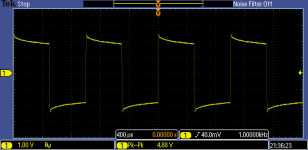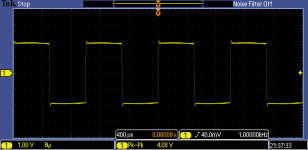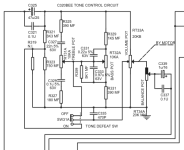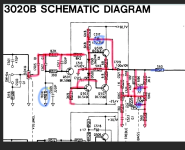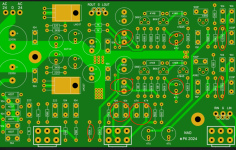Been playing around with a NAD 3020e today.
On my unit, I noticed that the tone controls are not neutral in the center position. There is too much high frequency peaking on the square wave. So if you own one of these, you might want to check yours.
The first image shows the default response with all tone controls in the middle. The second image shows the response after turning down the treble 2.5 dots. Bass seemed to be about right.
Cheers,
On my unit, I noticed that the tone controls are not neutral in the center position. There is too much high frequency peaking on the square wave. So if you own one of these, you might want to check yours.
The first image shows the default response with all tone controls in the middle. The second image shows the response after turning down the treble 2.5 dots. Bass seemed to be about right.
Cheers,
Attachments
It can be changed modifing the components at it, supposing it's analog (Baxandall or similar).
It may be a defective element or a condition of design.
It may be a defective element or a condition of design.
I've seen many older integrated amps do that.
I often wondered if it was intentional to make them sound a tad brighter in the default settings.
Hugo
I often wondered if it was intentional to make them sound a tad brighter in the default settings.
Hugo
In my opinion, when making conjectures, what matters most is experience rather than hypotheses. 🙂
Then if one wants to "repair" something then he would first have to verify if it is broken.
From my modest point of view, I had thought that the pots were the easiest thing to check, if not to "clean". 😉
Edit to add the following link which might be of interest
https://www.diyaudio.com/community/threads/help-w-nad-3020e.286952/
I've seen many older integrated amps do that.
Then if one wants to "repair" something then he would first have to verify if it is broken.
From my modest point of view, I had thought that the pots were the easiest thing to check, if not to "clean". 😉
Edit to add the following link which might be of interest
https://www.diyaudio.com/community/threads/help-w-nad-3020e.286952/
Last edited:
I believe a tone-controlled amplifier needs to be evaluated with the tone controls bypassed. Some amplifiers like the NAD 320bee have a switch for that. Tone controls may introduce phase-shifts and distortion of square waves.Been playing around with a NAD 3020e today.
On my unit, I noticed that the tone controls are not neutral in the center position. There is too much high frequency peaking on the square wave......
OK, unless I have made a typing mistake in the simualtion


then the output in regulators' neutral position should be like this:

Looks like a bit bass heavy to me..
I would run RMAA frequency response on that amplifier before making any judgments.
then the output in regulators' neutral position should be like this:
Looks like a bit bass heavy to me..
I would run RMAA frequency response on that amplifier before making any judgments.
Yes, but this thread amplifier is 3020e - service manual is available at Elektrotanya.Nad 3120
Yes I know, the 3120 is generally a 3020 without tone corrector, that gives good bases for modifying the 3020e. 🙂
It depends what is the goal. If the only goal is to make the frequency response flat in the regulators' neutral position then it can probably be done quite easily by modifying its tone filter components.that gives good bases for modifying the 3020e.
If the goal is some heavier modification then it is another story.
Good point .
Two solutions are available to the OP, either he corrects it or he bypasses the tone controls.
In any case, as I told Poundy, replacing the volume potentiometer with a quality model is really worth it on this amp.
Two solutions are available to the OP, either he corrects it or he bypasses the tone controls.
In any case, as I told Poundy, replacing the volume potentiometer with a quality model is really worth it on this amp.
I didn't check it all - but your R305 may be wrong, it's 82k according to the parts list in the manualOK, unless I have made a typing mistake in the simualtion
Correct you are - probably my reading mistake from the schematic somewhat blurred image.R305 may be wrong, it's 82k according to the parts list in the manual
There is a difference from the original board on this board I want to change the resistors on this board! as in the original! Is it possible? Are these resistor values correct? or should I select everything exactly as in the diagram in the book nad 3020 b. blue color is different from original r 515. -180 k (220k) c517 220 uf (47uf) c527 -c529 What kind of potentiometers should I take for this circuit? Input 20k (linear?) for loudness compensation (10k - linear?
Attachments
In my experience repairing old amplifiers, many times the volume and balance potentiometers are very out of value, even in the dual ones, affecting the balance between channels and a very bad tracking, it would not be surprising if the same thing happened with the tone control potentiometers, especially with these types of anti-logarithmic resistive curve "C"He estado jugando con un NAD 3020e hoy.
En mi unidad, noté que los controles de tono no son neutros en la posición central. Hay demasiados picos de alta frecuencia en la onda cuadrada. Entonces, si posee uno de estos, es posible que desee verificar el suyo.
La primera imagen muestra la respuesta predeterminada con todos los controles de tono en el medio. La segunda imagen muestra la respuesta después de bajar los 2,5 puntos agudos. Bass parecía tener razón.
Bien
- Home
- Amplifiers
- Solid State
- NAD 3020e tone controls
